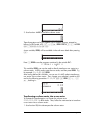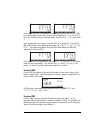
Page 10-1
Chapter 10!
Creating and manipulating matrices
This chapter shows a number of examples aimed at creating matrices in the
calculator and demonstrating manipulation of matrix elements.
Definitions
A matrix is simply a rectangular array of objects (e.g., numbers, algebraics)
having a number of rows and columns. A matrix A having n rows and m
columns will have, therefore, n×m elements. A generic element of the matrix is
represented by the indexed variable a
ij
, corresponding to row i and column j.
With this notation we can write matrix A as A = [a
ij
]
n×m
. The full matrix is
shown next:
A matrix is square if m = n. The transpose
of a matrix is constructed by
swapping rows for columns and vice versa. Thus, the transpose of matrix A, is
A
T
= [(a
T
)
ij
]
m×n
= [a
ji
]
m×n
. The main diagonal of a square matrix is the
collection of elements a
ii
. An identity matrix, I
n×n
, is a square matrix whose
main diagonal elements are all equal to 1, and all off-diagonal elements are
zero. For example, a 3×3 identity matrix is written as
An identity matrix can be written as I
n×n
= [δ
ij
], where δ
ij
is a function known as
Kronecker’s delta
, and defined as
.
.][
21
22221
11211
⎥
⎥
⎥
⎥
⎦
⎤
⎢
⎢
⎢
⎢
⎣
⎡
==
×
nmnn
m
m
mnij
aaa
aaa
aaa
a
L
OMM
L
L
A
⎥
⎥
⎥
⎦
⎤
⎢
⎢
⎢
⎣
⎡
=
100
010
001
I
⎩
⎨
⎧
≠
=
=
jiif
jiif
ij
,0
,1
δ


















